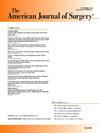外科技能客观评价指标在医学教育中应用的前景:20年范围综述
IF 2.7
3区 医学
Q1 SURGERY
引用次数: 0
摘要
目的自动、客观的评价指标可以解决手术技能主观评价容易受个体主观性影响的局限性,提供更全面、准确的评价方法。本研究的目的是调查、综合和讨论目前文献报道的各种客观的外科技能评估指标。方法按照PRISMA-ScR报告指南在PubMed医学数据库中进行系统检索。纳入标准包括涉及医疗保健行业参与者的研究以及涉及手术模拟或真实手术过程的场景。研究涉及两个方面的客观评价指标:技术技能(TS)和非技术技能(NTS)。结果检索文献3366篇,符合纳入标准的文献70篇。根据纳入的文献所采用的客观评价方法,有的涉及多种方法(n = 3),目前的手术技能实时客观评价指标可分为物理指标(n = 29)、脑功能相关生理指标(n = 30)和非脑功能相关生理指标(n = 14)。手术类型包括开放手术、微创手术和基础手术,手术设置包括模拟手术和对真实患者的手术。结论目前,外科技能自动客观评价指标的研究尚处于起步阶段,能够反映新手与专家的差异,但缺乏普遍、准确、细致的区分能力。有必要发展多维度、多场景的综合评价方法。本文章由计算机程序翻译,如有差异,请以英文原文为准。
Prospects for the use of objective assessment indicators of surgical skills in medical education: a twenty-year scoping review
Purpose
Automatic and objective evaluation indicators can address the limitations of subjective assessments of surgical skills that are easily influenced by individual subjectivity and provide a more collected and accurate evaluation method. The aim of this study is to investigate, synthesize, and discuss various objective assessment indicators for surgical skills as reported in current literature.
Method
A systematic search was conducted in the PubMed medical database following the PRISMA-ScR reporting guidelines. Inclusion criteria encompassed studies involving participants from the healthcare industry and scenarios involving surgical simulations or real surgical procedures. The research involved objective assessment indicators in two aspects: technical skills (TS) and non-technical skills (NTS).
Result
After searching 3366 articles, 70 articles met the inclusion criteria. According to the objective assessment methods used in the included literature, some of which involve multiple methods (n = 3), the current real-time objective assessment indicators of surgical skills can be divided into physical indicators (n = 29), physiological indicators related to brain function (n = 30), and physiological indicators related to non-brain function (n = 14). The surgery types encompassed open surgical procedures, minimally invasive surgical procedures, and basic operations, while the surgical settings involved simulation-based surgery and surgery on real patients.
Conclusion
Currently, research on automatic and objective assessment indicators for surgical skills is in its preliminary stages, and it can indicate the difference between novices and experts, but it lacks the ability of universal, accurate, and detailed differentiation. It is necessary to develop multi-dimensional and multi-scenario combined evaluation methods.
求助全文
通过发布文献求助,成功后即可免费获取论文全文。
去求助
来源期刊
CiteScore
5.00
自引率
6.70%
发文量
570
审稿时长
56 days
期刊介绍:
The American Journal of Surgery® is a peer-reviewed journal designed for the general surgeon who performs abdominal, cancer, vascular, head and neck, breast, colorectal, and other forms of surgery. AJS is the official journal of 7 major surgical societies* and publishes their official papers as well as independently submitted clinical studies, editorials, reviews, brief reports, correspondence and book reviews.

 求助内容:
求助内容: 应助结果提醒方式:
应助结果提醒方式:


